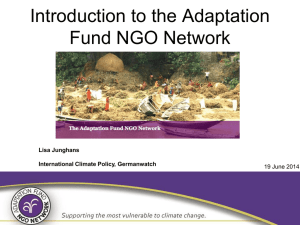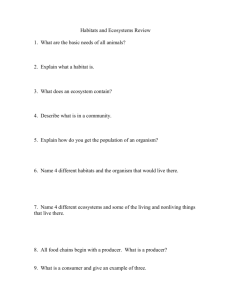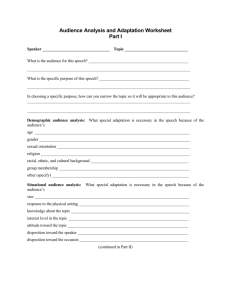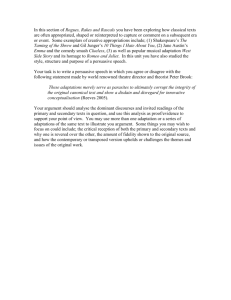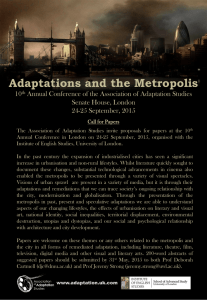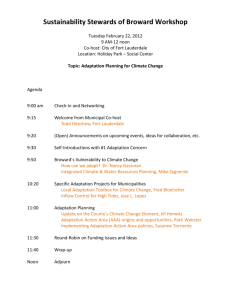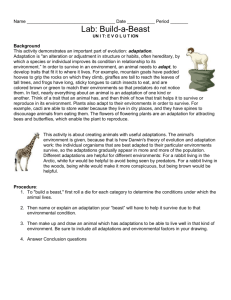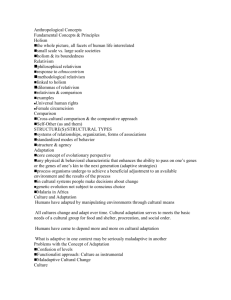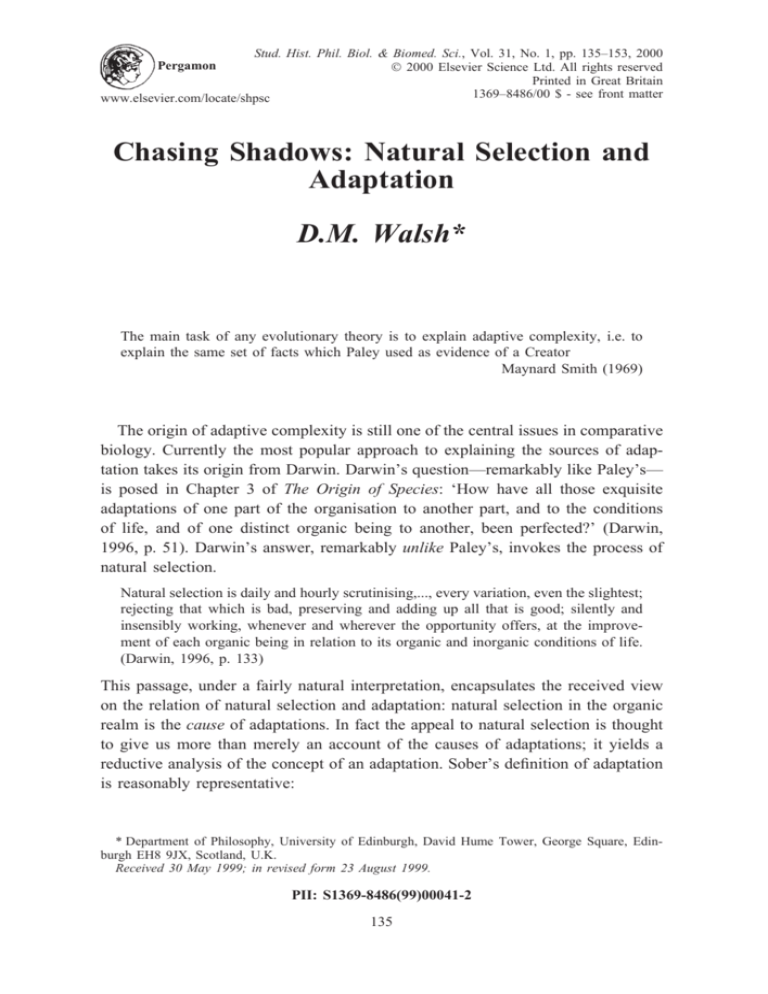
Stud. Hist. Phil. Biol. & Biomed. Sci., Vol. 31, No. 1, pp. 135–153, 2000
2000 Elsevier Science Ltd. All rights reserved
Printed in Great Britain
1369–8486/00 $ - see front matter
www.elsevier.com/locate/shpsc
Pergamon
Chasing Shadows: Natural Selection and
Adaptation
D.M. Walsh*
The main task of any evolutionary theory is to explain adaptive complexity, i.e. to
explain the same set of facts which Paley used as evidence of a Creator
Maynard Smith (1969)
The origin of adaptive complexity is still one of the central issues in comparative
biology. Currently the most popular approach to explaining the sources of adaptation takes its origin from Darwin. Darwin’s question—remarkably like Paley’s—
is posed in Chapter 3 of The Origin of Species: ‘How have all those exquisite
adaptations of one part of the organisation to another part, and to the conditions
of life, and of one distinct organic being to another, been perfected?’ (Darwin,
1996, p. 51). Darwin’s answer, remarkably unlike Paley’s, invokes the process of
natural selection.
Natural selection is daily and hourly scrutinising,..., every variation, even the slightest;
rejecting that which is bad, preserving and adding up all that is good; silently and
insensibly working, whenever and wherever the opportunity offers, at the improvement of each organic being in relation to its organic and inorganic conditions of life.
(Darwin, 1996, p. 133)
This passage, under a fairly natural interpretation, encapsulates the received view
on the relation of natural selection and adaptation: natural selection in the organic
realm is the cause of adaptations. In fact the appeal to natural selection is thought
to give us more than merely an account of the causes of adaptations; it yields a
reductive analysis of the concept of an adaptation. Sober’s definition of adaptation
is reasonably representative:
* Department of Philosophy, University of Edinburgh, David Hume Tower, George Square, Edinburgh EH8 9JX, Scotland, U.K.
Received 30 May 1999; in revised form 23 August 1999.
PII: S1369-8486(99)00041-2
135
136
Studies in History and Philosophy of Biological and Biomedical Sciences
[Trait] A is an adaptation for task T in a population P if and only if A became prevalent
in P because there was selection for A, where the selective advantage of A was due
to the fact that A helped perform task T (Sober, 1984, p. 208).1
The significance of this reductive analysis of adaptation is difficult to overestimate. It seems that adaptation is indispensable to evolutionary biology not merely
as explanandum but also as explanans. The presence of a trait is often explained
by citing what it is an adaptation for. Examples of this form of explanation abound:
the capacity of chameleons to match their colour to that of their surroundings is
explained by the fact that this is an adaptation for avoiding predators; the presence
of sonar in bats is explained by the fact that sonar functions as a device for navigation in dark environments. Taken at face value these adaptive, functional explanations appear to explain the presence of a trait by appeal to the way it subserves
an organism’s goals or purposes. They are teleological. Of course, in post-Galilean
science, we are told, there is no room for such explanations. It is a feature of the
‘anti-Aristotelian purge’ of the natural sciences that no natural phenomenon can
be explained by appeal to goals, ends or purposes.2 There are no purposes in nature,
only causes. The reductive analysis of adaptation allows us to recast adaptive explanations in the causal mode. If to be an adaptation is to be the product of natural
selection, then to explain the presence of a trait by appeal to what it is an adaptation
for is to explain the effect that the trait had in the past which caused it to be
promoted by natural selection. For example, the capacity of chameleons to match
their colour to that of their immediate environment is an adaptation for the avoidance of predators because this trait was promoted by selection in the past; it has
the selectively salient effect of making chameleons difficult for predators to detect.
This is a strictly efficient-cause type of explanation. There is no irreducible appeal
to the purposes or goals of an organism. There is simply an appeal to the causal
efficacy of natural selection: to cite Paul Griffiths’ adage, ‘where there is selection
there is teleology’ (Griffiths, 1993, p. 420). Natural selection makes available to
us a sanitised, rehabilitated form of reductive, naturalised teleology.3
This is by now an extremely familiar story. One needs only to consult the recent
collections of papers on adaptation, function and natural teleology to realise the
impact it has had.4 Its success relies upon the success of each of two constituent
claims: i) that adaptations (and correlatively functions) are the causal consequences
of natural selection; and ii) that explanations which appeal to adaptation (and
function) may be reconstructed, giving them a strictly aetiological cast. The truth
1
There are non-historical definitions of adaptation. See Brandon (1978); Reeve and Sherman (1993).
For a marvellous account of the history of the concept of adaptation I recommend Amundson (1996).
2
See Buller (1999, pp. 1–28) for an illuminating discussion of the difficulties posed by functional,
adaptive explanations to the standard model of scientific explanation. The term ‘anti-Aristotelian purge’
originates with Charles Taylor (1989, p. 59). I thank Matthew Elton for directing me to it. See also
Taylor (1964, ch. 1).
3
See also Lennox (1995).
4
See for instance Allen et al. (1998) and Buller (1999).
Chasing Shadows: Natural Selection and Adaptation
137
of the second claim is clearly dependent on that of the first. Much has been written
about the latter phase of this reductive approach to biological teleology, but to my
knowledge little has been said about the former. It has been more or less taken
for granted—sanctioned by the orthodox reading of The Origin of Species. Nevertheless, I believe it to be false. Natural selection in the organic realm cannot causally explain adaptations because it is not the cause of adaptation. When we look
more closely at the causes of evolutionary change we find that natural selection
and adaptation are indeed related as explanans and explanandum, but the relation
is the converse of that usually supposed. The process of adaptation causes, and
hence explains, the particularly distinctive nature of selection in the biotic realm.
The source of the error, I believe, lies not in the Origin itself but in an erroneous
metaphysical picture drawn from the Modern Synthesis theory of evolution. That
theory explicitly construes selection as a force acting over populations of genes. I
suggest that in the search for the causes of adaptation we should look not to the
statistical structure of populations of genes but to the generic principles which
determine the organisation and development of individuals.
1. The Forces of Evolution
Modern evolutionary theory, largely inherited from Darwin, is conceived as a
theory of forces acting upon populations (Sober, 1984). Prior to Darwin biologists
attempted to explain the diversity of form, and the prevalence of adaptation, in
terms of the properties of individuals (Mayr, 1982). Typically, they invoked the
inherent tendencies of organisms to strive to attain their ideal forms. Darwin’s
theory is a radical departure. It relies upon certain observations concerning the
structure and behaviour of populations. Darwin noticed that the heritable variation
in traits within a population determined differential rates of survival and reproduction within individuals. He surmised that over the course of time, because of
this differential survival and reproduction, the constitution of a population changes.
It comes to be constituted of individuals which possess those heritable characters
which enhance survival and reproduction. Indeed it is thought that Darwin’s most
significant conceptual breakthrough was the shift from individual thinking to what
Mayr has called ‘population thinking’ (Mayr, 1982). Sober (1980) expresses the
view concisely:
Darwin ...focussed on the population as a unit of organisation. The population is an
entity, subject to its own forces, and obeying its own laws. The details concerning
the individuals who are parts of this whole are pretty much irrelevant. Describing a
single individual is as theoretically peripheral to a populationist as describing the
motion of a single molecule is to the kinetic theory of gases. In this important sense,
population thinking involves ignoring individuals. (Sober, 1980, emphasis in original.
Quoted from Sober, 1984, p. 175)
138
Studies in History and Philosophy of Biological and Biomedical Sciences
There is a certain amount of scholarly debate concerning the degree to which
Darwin himself thought along these lines (see Schweber, 1985; Depew and Weber,
1995). But this much is certain: the modern-synthesis theory of evolution which
followed was developed expressly along the ‘population thinking’ model. It is conceived explicitly on the model of statistical dynamics (Fisher, 1958). The central
idea is that a population is an ‘aggregate of gene ratios’. The laws of evolution,
like the gas laws, describe the behaviour of ideal populations of genes.5 The fundamental forces affecting gene frequencies are taken to be natural selection and
mutation. Variants of the modern synthesis theory differ over the relative importance to be placed upon those factors which divert a population from the ideal
conditions—factors like the finite size of populations, non-random mating, epistatic
interactions between genes. Nevertheless they appear in agreement over the view
that natural selection is a force, or the principal force, acting on populations which
alters gene frequencies and in turn produces adaptations. It will be worthwhile, I
believe, to look a little more closely at this putative force of selection.
Natural selection, we are told, works on heritable variation in fitness (Lewontin,
1974). Fitness is usually taken to be a property of an individual, specifically its
propensity to survive and reproduce (Mills and Beatty, 1979).6 Whenever differences in these propensities between individuals are manifested there is selection.
These propensities, in turn, are realised through the systematic causal contribution
of an individual’s traits to its survival and reproduction. This much, I think, should
already be obvious from the reductive account of adaptation outlined above. If you
want to explain why a trait is prevalent in a population you must cite the way
traits of its type have contributed to the survival and reproduction of individuals
in the past. For a trait to have been selected for in the past is just for it to have
contributed (disproportionately) to the survival and reproduction of individuals in
the past. The cause of the changes in trait frequency that natural selection is supposed to explain appears to be nothing more than the systematic contribution of
heritable traits to survival and reproduction of individuals. This point is often overlooked, but it is amply demonstrated in the recent units-of-selection debate.
The units-of-selection debate, as it is usually interpreted, is a debate over the
causes of evolutionary change. Do traits (genes) evolve because they benefit individuals or do they evolve because they merely benefit genes? Gene selectionists maintain
that the unit of selection is always the gene; traits evolve only because they benefit
genes and selection is a force which alters gene frequencies. Consequently, there is
selection when and only when gene frequencies change. Individual selectionists
maintain that the unit of selection is often the individual, perhaps sometimes the
group (Sober and Lewontin, 1982; Sober and Wilson, 1994). Sober and Lewontin
5
See Fisher (1958, p. 37ff.) and also Hodge (1992) for an extensive discussion of Fisher’s analogy
between natural selection theory and statistical dynamics.
6
This is a notoriously tricky concept to state precisely; but nevertheless, the propensity account of
fitness appears to be on the right track.
Chasing Shadows: Natural Selection and Adaptation
139
(1982) offer the example of individual selection without a change in gene frequencies. Consider a case of extreme heterosis. For some locus with two alleles A
and a, the heterozygotes (Aa) are on average extremely robust, while the homozygous
condition (AA or aa) is lethal. Only the heterozygotes survive long enough to reproduce. At mating all individuals will be heterozygotes, so the frequency of A ⫽ a ⫽
0.5. After mating, however, not all individuals will be heterozygotes. The frequencies
of genotypes will be AA ⫽ 0.25, Aa ⫽ 0.5, aa ⫽ 0.25. The gene frequencies,
however, will remain constant throughout: A ⫽ a ⫽ 0.5. According to the gene
selectionist there is no selection in this system because from one generation to the
next, and even within a generation, there are no changes in gene frequencies. But,
Sober and Lewontin protest, this conclusion misrepresents the causes of stasis in
gene frequencies. There is selection of the heterozygotes; only they survive to breeding age. As a consequence, at segregation the proportion of A gametes is equal to
the proportion of a gametes. At mating these gametes combine in the proportions
given above. The reason they do not change is a combination of selection for the
heterozygote individuals and the laws of Mendelian genetics.
Some gene selectionists take a slightly different tack (e.g. Kitcher and Stereleny,
1988; Williams, 1966). They respond that this situation can be reinterpreted or
redescribed from the gene’s point of view. In fact, they claim that, no matter what
causal relations are involved, selection can always be ‘represented algebraically’
in terms of changes of gene frequency. Natural selection, according to this view,
is merely a mathematical descriptor for changes in gene frequencies. In many ways
I find this an unobjectionable position, but it is worth noting that it offers little
succour to those who claim that natural selection causes changes in gene frequencies. Natural selection on this account is not a causal concept. It is merely a
device for representing changes in gene frequencies.7
Sober and Lewontin conclude that if selection is to yield causal explanations we
must construe it as a genuinely causal process which acts on individuals.8 But
what are the causal processes involved here? As I have said, selection is simply a
consequence of traits making a systematic causal contribution to the survival and
reproduction of individuals. Natural selection, it seems, is merely the consequence
of an assemblage of causal processes taking place at the individual level. There is
no need to invoke a distinct force operating over populations in order to explain
the sort of changes in gene frequency thought to be explained by natural selection.
Indeed, it is tempting to suppose that if there were such a force, it couldn’t be
natural selection. Suppose there were some force which caused a process p which
is distinct from the assemblage of processes comprising the survival and reproduction of individuals. Could p explain the changes in trait frequencies which are
the causal consequence of the contribution of traits to survival and reproduction?
7
See Sober and Wilson (1994) for a discussion of the ‘bookkeeping’ argument for gene selectionism.
I am restricting my attention here to cases of individual selection, prescinding from the issue of
whether there is selection at other levels of organisation.
8
140
Studies in History and Philosophy of Biological and Biomedical Sciences
Clearly not. But if p couldn’t explain that, it couldn’t explain what natural selection
is required to explain. Whatever process p might be, it couldn’t be the process of
natural selection. So, given the explanatory role selection is required to play it
must be the consequence only of the systematic causal contribution of traits to the
survival and reproduction of their bearers.
This argument has an air of sophistry about it. Natural selection might well be
a genuine causal process which comprises an aggregate of distinct causal processes.
There must surely be such aggregates of processes. The processes of metabolism
and meiosis, for example, are genuine causal processes made up of distinct component causal processes. But it is worth noting that selection appears to be composed
of its component processes in a quite distinctive way. The mere aggregate of individual survival and reproduction is not sufficient for selection. Selection only
occurs as a consequence of the difference between individual-level processes. One
could eliminate natural selection entirely by increasing the propensity of occurrence
of one of its component processes. One could not, by contrast, eliminate the process
of photosynthesis entirely by increasing the propensity of one of its component
processes to occur. Perhaps by altering the propensity of a component process of
photosynthesis one could affect the final outcome, perhaps even cause the discontinuation of the process, but that would not be the same as bringing it about that
no such process occurs at all. It is tempting to suggest that, rather than being a
population-level causal process, natural selection isn’t a causal process at all. It
bears the hallmarks of a pseudoprocess.
Imagine that you are chasing a shadow, perhaps one cast on the surface of the
earth by the flight of an aeroplane. The motion of the shadow looks like an ordinary
process, very much like your own motion. At each moment it has an instantaneous
velocity; it has a trajectory, a history. But the movement of the shadow is no
ordinary process: it’s a pseudoprocess. It is simply the by-product of a set of other
genuine causal processes which include: the flight of the aeroplane, the emission
of photons from the sun, their collision with the aeroplane and their absorption by
the surface of the plane, the collision of the photons with the ground around the
shadow and the reflection of light off the earth’s surface. The motion of a shadow—
like the change in gene frequencies within a population—is a consequence of the
difference between the effects of genuine causal processes. A shadow moves just
when the boundary between the area of high illumination and low is shifted. Unlike
your own motion, the motion of a shadow cannot be altered by imparting a force
to it. To alter the trajectory of a shadow you must bring about a change in the
differential rate of photon bombardment on the surface. Unlike the shadow, you
have momentum and mass; changes to your shape, mass, and charge may be transmitted from one phase of your motion to a later phase.9 Successive phases of your
9
For various attempts to draw up a strict criterion for demarcating pseudoprocesses see Salmon (1984,
1998); Dowe (1992, 1995).
Chasing Shadows: Natural Selection and Adaptation
141
motion are directly causally connected. In contrast, successive phases of a shadow’s
motion are related as effects of a common cause. Your motion, unlike that of the
shadow, is a genuine causal process.
I suggest that the process of selection is more like the motion of a shadow than
it is like your own motion. It is simply the consequence of the differential rates
of distinct causal processes occurring within individuals. Of course changes in trait
frequencies are themselves simply the consequences of the differences in these
same processes. Natural selection and changes in gene frequencies are not related
as cause and effect; they are joint effects of a common cause. Natural selection
does not cause changes in gene frequencies.
The causal inefficacy of selection should not be taken to imply that it is explanatorily idle. Pseudoprocesses may well be invoked in causal explanations. We may
explain a sudden change in the temperature of a surface by saying a shadow passed
over it. This explanation stands proxy for an explanation which involves a suite
of genuinely causal processes. Closer to home, Elliott Sober (1987) has suggested
that the inheritance of phenotypes is itself a pseudoprocess. It comprises the causal
processes of meiosis, gamete fusion, transcription, protein synthesis etc.. Even so,
the heritability of phenotypes is explanatorily important. One only needs to look
at the recent Bell Curve debate to see this. Herrnstein and Murray (1994) argue that
differences in IQ between various socioeconomic and ethnic groups are narrowly
heritable. Detractors (e.g. Block, 1995) counter that IQ is not heritable. They manifestly do not claim that heritability is not explanatory. In the same way, I believe
that natural selection may be explanatorily significant in evolutionary biology, even
though it is not a force acting on populations. It stands proxy for a suite of genuinely causal processes operating on individuals.
This is not to say that the population-thinking model of evolutionary change is
wrong. It is, after all, populations and not individuals which undergo adaptive
evolution. Moreover, they do so simply by changing their constitution, just as Darwin surmised. The unit of evolution, we might properly say, is the population.
However, it does not follow from the fact that the effect—change in trait frequencies—is a population property that the cause must be a population-level force.
The modern synthesis theory does not sanction the metaphysical claim that selection causes changes in gene frequencies. Rather, it appears that the causes of
changes in gene frequencies are the processes which determine the propensities of
individuals to survive and reproduce. If we are interested in causal explanations
of changes in trait frequency, we should look not to the statistical structure of
‘aggregates of genes’ but to the constitution of individuals.
2. The Source of Adaptation
Thus far I have discussed only the putative causal role of selection in changing
trait frequencies within a population. The preliminary conclusion is that selection
is not the cause of changes in trait frequencies; instead selection and changes in
142
Studies in History and Philosophy of Biological and Biomedical Sciences
trait frequencies are joint effects of those causal processes which determine the
propensities of individuals to survive and reproduce. But selection is generally
considered to be the cause of more than mere changes in trait frequencies. It also
causes adaptations. The dual roles of selection are described by Ayala.
Natural selection has been compared to a sieve which retains the rarely arising useful
mutations and lets go the frequently arising harmful mutants. Natural selection acts
in this way, but it is much more than a purely negative process, for it is able to
generate novelty by increasing the probability of otherwise extremely improbable
genetic combinations. Natural selection is creative in a way. (Ayala, 1970, p. 5)
Natural selection in the organic realm is both a winnower and, to borrow François
Jacob’s phrase, a tinkerer. Of course the two effects are related. The passage quoted
from Ayala suggests that by changing trait gene frequencies, selection enhances
the probability of new complex adaptations arising: selection tinkers by winnowing.10 The view is put forward forcefully by Dawkins.
Darwinism—the non-random selection of randomly varying replicating entities is the
only force I know that can, in principle, guide evolution in the direction of adaptive
complexity. The ingredients in a general recipe for Darwinian selection are replicating
entities of some kind, exerting phenotypic ’power’ of some kind over their replication
successes. (Dawkins, 1998, p. 32)
Wherever selection occurs, so long as it is permitted to run for long enough, there
will be an increase in adaptive complexity. The general picture, I take it, is that
because selection causes changes in trait frequencies and these in turn are a positive
causal factor in the origin of adaptations, selection itself is a positive causal factor
in the origin of adaptations, a point made most explicitly by Neander.
Selection does more than merely distribute genotypes and phenotypes...: by distributing existing genotypes and phenotypes it plays a crucial causal role in determining
which new genotypes and phenotypes arise. (Neander, 1995, p. 585, emphasis in
original)
The foregoing discussion should raise some doubts. If natural selection isn’t the
cause of changes in gene frequencies, it is probably not the cause of adaptive
complexity either. Selection, as we have seen, is merely the consequence of differential propensities of individuals in a population to persist or replicate. It is difficult
to see how these propensities alone should generate adaptive complexity.
As a matter of fact, they don’t. Selection as a general phenomenon is widespread
but in very few arenas does it lead to increases in adaptive complexity. Marc Bedau
(1991) discusses an imaginary scenario: Suppose we have a population of crystals
in solution which vary slightly in their structure in a way that determines that
crystals of one sort more rapidly form stable lattice structures than do crystals of
other sorts. One would naturally expect that crystals of this faster growing sort
would come to be disproportionately represented in a population of growing crys10
See Neander (1995) for a development of this position.
Chasing Shadows: Natural Selection and Adaptation
143
tals. This is a case of selection, but there is no adaptation here. The structures
which confer on crystals a faster growth rate are not adaptations (Bedau, 1991;
Matthen, 1997). More to the point, populations of crystals of this sort do not exhibit
a tendency to become increasingly efficient at precipitating ions from solution.
Selection does not increase the rate of formation or the stability of the lattice structures.
Another example of selection without adaptation occurs in systems of convective
cells. When a pan of water is heated from beneath an energy gradient is set up
between the hot water at the bottom of the pan and the cooler water at the top.
When the energy gradient reaches a certain intensity, convective cells form. This
is the most efficient arrangement for the dissipation of energy through the water
column. There is both an optimal size and shape for a convective cell. The optimal
size is determined by the viscosity of the fluid and the capacity of the cell to
dissipate energy. The optimal shape is hexagonal, permitting the maximum packing
of cells. Those cells which are closer to the optimum are more stable. Cells which
are sub-optimal in size and or shape are less stable. Cells of smaller than optimal
size fuse to become larger cells; larger than optimal cells break up. Non-hexagonal
cells change their shape (Depew and Weber, 1995). The overall effect is a reduction
of variation in selectable parameters. In its stable state, a population of convective
cells (Benard cells) displays a remarkable uniformity in cell size and shape as a
‘consequence’ of selection. Even though there is selection, there is no adaptation
here. Once a stable equilibrium is attained, the system does not improve its dissipative capacities in any way. Furthermore, we could keep the selection process going
as long as we like by introducing perturbations of all sorts, but a population of
convective cells would still manifest no tendency toward an increase in adaptive
complexity.
Where selection occurs in populations of crystals or Benard cells it merely eliminates variants; it winnows. But when it operates over populations of organisms, we
are told, it tinkers. What is so special about natural selection operating over populations of organisms that makes it ‘able to generate novelty’? More to the point if,
as I have suggested, natural selection is not a causal process at all, but the net effect
of a series of individual-level processes in which individuals’ traits make a systematic
causal contribution to their survival and reproduction, the question becomes: ‘What
is so special about organisms which determines that their differential survival and
reproduction leads to adaptation?’. A common answer, offered by Dawkins (1986);
Stereleny (1988) and others is that only in populations of organisms is natural selection cumulative: ‘Cumulative selection is the hallmark of biology, and is, I believe,
the force underlying all adaptive complexity’ (Dawkins, 1998). I am willing to accept
that adaptive complexity comes about when selection is ‘cumulative’ and that only
biological populations undergo cumulative selection, but I submit that this gets us
no closer to uncovering the causes of adaptation. We still have no inkling of what
makes selection operating over populations of organisms ‘cumulative’ in a manner
144
Studies in History and Philosophy of Biological and Biomedical Sciences
sufficient to produce adaptations, whereas selection operating over populations of
crystals or convective cells is not.
It may be helpful in addressing this question to introduce the notion of an adaptive landscape. Since Sewall Wright (1932), it has become common to represent
natural selection of the sort that leads to adaptative complexity in terms of the
fitness landscape. The fitness landscape is a simple device for representing the
comparative fitnesses of genotypes. Suppose we have a population of haploid
organisms with N genes each, each of which has two alleles; there are, then, 2N
possible individual genotypes. We can imagine this assemblage of genotypes laid
out on a multidimensional surface like a map. The distances between genotypes
on the map correlates with their allelic differences. Each genotype has a fitness
value which is represented as an altitude on this multi-dimensional landscape. Less
fit individuals, those whose genotypes occupy lower altitudes on the fitness landscape, are eliminated by selection. Fitter individuals, those higher up, survive and
reproduce. New mutations and combinations occasionally—but often enough—produce individuals which occupy places slightly higher on the landscape. Through the
gradual accumulation of these fitter (higher ground) variants, and the elimination of
less fit (lower ground) ones, selection gradually drives a population to local fitness
maxima on the adaptive landscape.
The imagery of the adaptive landscape is a useful one. It demonstrates not that
adaptive evolution is an inevitable consequence of selection, but that it requires
specific sorts of landscapes. The first requirement for a landscape on which adaptive
evolution can occur is that the fitnesses of neighbouring genotypes are reasonably
highly correlated. Similar (neighbouring) genotypes must have quite similar fitnesses. If the fitness landscape is highly uncorrelated, then for any genotype, its
neighbouring (similar) genotypes will be wildly different in fitness. In this case,
the effect of any particular gene is so largely dependent upon its context (i.e. the
other genes it is associated with) that no gene makes a systematic, relatively uniform contribution to fitness. Consequently selection could not be expected to drive
any one gene or set of genes to fixation. It may eliminate various genotypes, but
it will not tend to favour any particular genes over the long term. Populations will
not be driven gradually by selection toward local maxima because these adaptive
landscapes are not made up of gently undulating hills and valleys. They are random
and jagged; and adaptive evolution—the gradual accumulation and combination of
beneficial traits—cannot occur on them (Kauffman, 1995). There is selection, but
no adaptation; winnowing, but no tinkering.
Nor would adaptive evolution occur on a very smooth landscape with only a
single global maximum—a Mt Fujiyama landscape.11 There are two reasons to
suppose that adaptive evolution does not occur on Fujiyama landscapes: one is a
reason to suppose it doesn’t, the other a reason to suppose it couldn’t. Darwin and
11
The imagery is taken from Kauffman (1995, ch. 8).
Chasing Shadows: Natural Selection and Adaptation
145
his predecessors, recall, were struck so profoundly by the staggering diversity of
adaptive forms. There isn’t just one solution to the problems of surviving and
reproducing, there are enormously many. The biological world is replete with all
sorts of adaptations. Intermediate states between these adaptations are not adaptations at all.12 So it looks like an explanation of adaptive diversity requires us to
think of the adaptive landscape as multiply peaked. A second reason is that on a
Fujiyama landscape, even very slow rates of mutations would cause a population
not to climb to a peak, but to seep down the slope. The vast majority of mutations
would represent a lower altitude on the adaptive landscape. Every mutation would
cause the population to move on average downhill. Where the selection coefficients
are low—where the slopes are shallow—the effect of the accumulation of mutations
would not be new adaptations but a decrease in the average adaptedness within a
population. Populations would exhibit little tendency to cluster around the single
adaptive peak (Wright, 1932).13 If adaptive evolution is to occur, then populations
must inhabit reasonably highly-correlated, multiply-peaked landscapes.
The adaptive landscape that a population inhabits determines its capacity to
undergo adaptive evolution. But what determines the sort of landscape a population
inhabits? The landscape is just an abstract representation of the relative fitnesses
of each (total) genotype. Fitness, recall, is the propensity of an individual to survive
and reproduce as determined by the systematic causal contributions of its heritable
traits. Ultimately, it is the nature of the processes which determine the propensity
of individuals to survive and reproduce which determines the kind of adaptive
landscape a population inhabits. So, ultimately it is the make-up of individuals
in a population that determines whether the population is capable of undergoing
adaptive evolution.14
How far have we got? We started with Darwin’s question: ‘how have all these
magnificent adaptations arisen?’. So far we have the following answer:‘through the
differential survival and reproduction of individual organisms, populations of which
inhabit multiply-peaked, highly-correlated landscapes’. Now it seems we have a
corollary question: ‘What sort of things are individual organisms such that populations of them inhabit these fitness landscapes?’. In a sense this latter question is
more fundamental than Darwin’s—an answer to it is a prerequisite to an answer
to Darwin’s question. I shall call it ‘Kauffman’s Question’.
3. Kauffman’s Question
Kauffman lays out his views of the source of adaptation in his Origins of Order
(1993) and later in his more accessible book At Home in the Universe (1995). The
12
This point is amply demonstrated by the studies of morphological variation in Darwin’s finches.
See Weiner (1995) for a synopsis.
13
I thank Alexander Bird for helpful discussion on this point. There is a further (better) reason to
suppose that adaptive evolution cannot occur on Mt. Fujiyama landscapes. I discuss this below.
14
There are other contributing factors, particularly mutation rate. I shall discuss this below.
146
Studies in History and Philosophy of Biological and Biomedical Sciences
earlier book begins with a question remarkably reminiscent Darwin’s. Kauffman
asks ‘What are the sources of the overwhelming and beautiful order which graces
the living world?’ (p. xiii). His answer, very roughly, is that the order found in
the organic world, the diversity of adaptive responses to evolutionary problems, is
largely a consequence of the intrinsic natures of individual organisms. Organisms,
according to Kauffman, are self-organising, complex dynamical systems. Order and
adaptation are consequences of the basic principles of self-organisation in these
sorts of complex systems.
Kauffman accepts much of the machinery of the modern-synthesis theory of
evolution: mutation, selection, drift. He even construes selection as a force acting
upon populations. But he sees the principles of self-organisation in complex systems as both a constraint on and a prerequisite to the creative power of selection.
Acknowledging that the complex adaptations of organisms such as neural and
immune systems are the result of mutation and selection, he asks:
How can such wonderful systems emerge merely through random mutation and selection? For if Darwin told us that adaptation occurs through the gradual accumulation
of useful mutations, he has not yet told us what kinds of systems are capable of
accumulating useful mutations. (Kauffman, 1993, p. 173)
The systems in question, of course, are organisms. I take it that one may paraphrase
Kauffman’s question as: What sorts of things are organisms, such that selection
of and mutation within them eventuates in adaptive evolution?
This is a striking departure from the approach we find in the standard accounts
of the modern-synthesis theory of evolution. Rather than starting from the structure
and the statistical dynamics of populations of genes, a perspective taken by the
modern synthesis theory, Kauffman’s approach focuses on the organisation and
development of individual organisms. Far from being ‘pretty much irrelevant’ to
the explanation of adaptive evolution, the nature of individuals is one of its principal determinants. Whereas on the traditional modern-synthesis view, the order we
see emerge during the development of organisms is strictly the causal consequence
of selection, Kauffman maintains that this order is more properly understood as a
consequence of the self-organising properties of extremely complex systems.
I present a countering thesis: most of the beautiful order seen in ontogeny is spontaneous, a natural expression of the stunning self-organization that abounds in very
complex regulatory networks. We appear to have been profoundly wrong. Order, vast
and generative, arises naturally.... I propose that much of the order in organisms may
not be the result of selection at all, but of the spontaneous order of self-organised
systems. (Kauffman, 1993, p. 25)
If we want an account of biological order, then, we should look not to some force
driving a population, but to the processes of self-organisation found in the development, survival and reproduction of individual organisms.
The principles of self-organisation are becoming increasingly well understood,
largely through the study of Artificial Life. As Boden characterises it:
Chasing Shadows: Natural Selection and Adaptation
147
The central concept of A-life, excepting life itself, is self-organization. Self-organization involves the emergence (and maintenance) of order, or complexity, out of an
origin that is ordered to a lesser degree. (Boden, 1996, p. 3, emphasis in original)
Of course, being a self-organising system isn’t sufficient for being the kind of
system populations of which can undergo adaptation evolution. The crystals and
Benard cells discussed above are examples of the spontaneous emergence of structured entities from less structured, simple components, but again there is no adaptation here. What more is needed to make a self-organising system the kind of
thing populations of which are susceptible to adaptive evolution? Here again,
Kauffman offers us a distinctive answer:
To engage in the Darwinian saga, a living system must first be able to strike an
internal compromise between malleability and stability. To survive in a variable
environment, it must be stable, to be sure, but not so stable that it remains forever
static. Nor can it be so unstable that the slightest internal chemical fluctuation causes
the whole teetering structure to collapse. (Kauffman, 1995, p. 73)
The key concept here is homeostasis. An organism must be able to maintain a
stable state despite perturbations, both internal and external. But mere stability is
not enough. Homeostasis involves responding to internal and external perturbations
by means of compensatory changes. If a system is too robust it cannot implement
compensatory changes; if it is too labile any internal change or external perturbation
will cause the complete collapse into disorder. Those systems best able to withstand
and compensate for perturbations are neither too rigidly ordered nor chaotic. They
are ‘poised on the edge of chaos’. Such poised systems, says Kauffman, ‘appear
to be best able to co-ordinate complex, flexible behavior and best able to respond
to changes in their environment’. (Kauffman, 1993, p. 29)
In fact, among self-organising systems, living things seem to be distinguished
by the possession of an extremely finely-honed capacity for maintaining homeostasis, of withstanding and adapting to internal and external perturbations. This
distinctive capacity has led Marc Bedau to propose that this is what constitutes
being a living thing:
The essential principle that explains the unified diversity of life seems to be the
suppleness of the adaptive processes—its unending capacity to produce novel solutions to unanticipated changes in the problems of surviving, reproducing, or, more
generally, flourishing. Some forms of adaptations are rigid, such as those exemplified
by artefacts like street lights or thermostats which have strictly limited options. By
contrast, supple adaptation involves responding appropriately to an indefinite variety
of ways to an unpredictable variety of contingencies. (Bedau, 1996, p. 338)
Organisms are, in short, complex, self-organising, adaptive systems. It is this
capacity to maintain and produce order through adaptive responses which makes
an organism an organism.
A-life models can simulate the conditions required for a self-organising system to
be capable of supple adaptation. Return to the model of haploid organisms having N
genes, each with two alleles, so that there will be 2N possible genotypes. We may
148
Studies in History and Philosophy of Biological and Biomedical Sciences
define a parameter K as the degree of interaction between genes within a genotype:
epistasis.15 Where K is equal to 0, there are no interconnections between genes,
and the phenotypic effects of each gene are entirely independent of all others.
Where K ⫽ N ⫺ 1, the phenotypic effects of each gene are influenced by every
other. Where there is no epistasis, developmental systems are robust and ordered,
incapable of adaptation. These systems settle into stable configurations from which
they are not deflected by perturbations (in the form of mutations). Where there is
high epistasis, developmental systems are chaotic; once perturbed, these systems
do not settle into a stable configuration. Where the degree of epistasis is small,
systems are capable of undergoing adaptation. They can sustain the development
of reasonably stable structures, despite the presence of a considerable number of
mutations. Some perturbations cause these systems to settle into new stable states.
‘This is a first hint of something like a construction requirement to make complex
systems with many interacting parts which remain perfectible by mutation and
selection. Each part should directly impinge on rather few other parts’. (Kauffman,
1993, p. 67).
Studies in molecular genetics bear this out. Most enzymes exhibit an enormous
amount of mutational variation, most of which has very little effect on fitness
(Kimura, 1968). Only occasionally will these mutations bring about phenotypic
differences. Most of these will be deleterious, but some will enhance fitness.
Lewontin (1974) calls this variant on the modern theory of selection which allows
for the accumulation of numerous neutral mutations, the neoclassical theory. The
importance of the neoclassical theory is that it is precisely what we should expect
if individual organisms are complex, self-organising systems with low (but not
very low) degrees of epistasis.
Finally, there is a connection between these developmental systems which are
able to sustain and adapt to mutations in their developmental programmes and the
sorts of populations which are capable of undergoing adaptive evolution. Populations of such individuals are precisely those which inhabit the adaptive landscapes
propitious for adaptive evolution.
We know that there is a clear link between the stability of the dynamical system
and the ruggedness of the landscape over which it adapts. Chaotic ...networks ... are
structurally unstable. Small changes wreak havoc on their behavior. Such networks
adapt on very rugged landscapes. In contrast, ... networks in the ordered regime are
only slightly modified by mutations to their structure. These networks adapt on relatively smooth fitness landscapes. (Kauffman, 1995, p. 187).
The lesson to be learned from all this is that the sort of fitness landscape which
is propitious for a population to undergo adaptive evolution is determined by the
generic properties of individuals which compose the population. It is not a matter
15
Again these models are taken from Kauffman. They are a response to yet another question that
Kauffman addresses: ‘We must ask that which Darwin did not broach: what kinds of integrated dynamical systems harbor the ability to adapt?’ (Kauffman, 1993, p. 209).
Chasing Shadows: Natural Selection and Adaptation
149
of population structure. It is a matter of the degree of integration in the development
of organisms. In short, it is only populations of individuals whose developmental
programmes allow them to adapt to internal and external perturbations which can
undergo adaptive evolution. The source of adaptation is the generic properties of
self-organisation of individual organisms.
4. Adaptation and Natural Selection
Where does that leave us in our initial problem of determining the relation
between selection and adaptation? I think we can discern three distinct positions.16
The traditional modern-synthesis view is that natural selection is a force
operating on an assemblage of genes. This force alters gene frequencies and by
doing so causes adaptations to occur in a population. Adaptation is a causal consequence of selection. I have adduced a few reasons for supposing this picture is
flawed. Natural selection seems not to have any causal efficacy of its own, at least
with respect to changes in gene frequencies. If selection does not cause changes
in trait frequencies then it cannot cause adaptations either, at least in the way
envisaged by the traditional modern-synthesis view. As we have seen, in order to
explain how selection could lead to adaptation, we need to take account of the
nature, particularly the development, of the individuals it operates over.
A second view, championed by Kauffman and his commentators (Burian and
Richardson, 1996; Weber and Depew, 1996), is that the principles of self-organisation somehow constrain the efficacy of natural selection; the principles of selforganisation determine the conditions propitious for selection. Yet, at the same
time, selection operates as a force which tends to drive a population toward adaptive peaks. On this picture selection and self-organisation are joint causes of adaptive evolution, or, equally likely, self-organisation and selection work antagonistically in the production of adaptations. This view is a hybrid; it countenances
distinct forces at two distinct levels. There is the force of selection operating over
assemblages of genes—as per the traditional modern-synthesis picture—and the
forces of development which determine the trajectories of individual organisms.
Its most notable feature is that much of the order in the biological world, much
of the adaptive complexity that we observe in individuals ‘comes for free’; it arises
in the absence of any population-level force.
This approach corrects at least one of the deficiencies of the standard modernsynthesis view by incorporating the principles of self-organisation into the explanation of adaptation. But it still accords a significant and distinct causal role to
natural selection (Weber and Depew, 1996). In fact, natural selection is given two
causal roles: i) it differentially retains in a population the better-adapted forms;
and ii) it ’molds’ the adaptive landscape, producing a population capable of climb16
Depew and Weber (1995); Weber and Depew (1996) offer roughly similar, but more finely split
taxonomies of possible positions.
150
Studies in History and Philosophy of Biological and Biomedical Sciences
ing adaptive peaks (Kauffman, 1995, p. 185). We have already seen that the first
of these effects is not a consequence of selection per se, but simply the consequence
of differential rates of survival and reproduction of individuals. If the considerations outlined in Sections 1 and 2 above are correct, this effect needs no population-level force to bring it about. But what of the second effect; how might selection ‘mold’ an adaptive landscape? The consequence of molding is a population
which inhabits a highly-correlated, multiply-peaked landscape. But, as we have
seen, the nature of the landscape inhabited by a population is determined by the
nature of the individuals in the population. So, again, a landscape is ‘molded’
simply by means of the differential retention in a population of individuals capable
of mounting adaptive responses to external and internal (including mutational) perturbations. The ‘molding’ of a fitness landscape is simply a concomitant of the
first role of selection. And the first role of selection, as we have seen, is merely a
consequence of the differential survival and reproduction of individuals. Here
again, we need posit no distinct population-level force, or process of selection.
This presents us with a third picture of the relation of adaptation to natural
selection. The discussion in Sections 1 and 2 suggests that natural selection could
not be a force or causal process operating over aggregates of genes. The discussion
of Section 3 suggests that no such causal process is required to explain the origin
of adaptations or the tendency of populations to undergo adaptive evolution. The
picture, in outline, is as follows. There is no distinct process or force of selection
which causes changes in trait frequencies or adaptations. There is merely the differential survival and reproduction of individuals. The processes which operate at the
individual level—those which determine the development, survival and reproduction of individuals—are themselves the causes of adaptations. I believe there
is much to credit in this view but it requires a reversal of the traditional conception
of the relation between natural selection and adaptation. Natural selection in the
organic realm is merely a shadow cast by the differential effects of the processes
of survival and reproduction which occur within individual organisms. Attempting
to explain adaptation as the causal consequence of natural selection is as futile as
chasing shadows. Natural selection in the organic realm, it would appear, is not the
cause of adaptation. Quite the reverse, the distinctive features of natural selection in
the organic world—its cumulative nature, its tendency toward increased adaptive
complexity—are consequences of the fact that the individual organisms it operates
over are complex, self-organising, adaptive systems.
5. Conclusions
There are at least three sorts of general conclusions which may be drawn from
this discussion. I shall merely gesture toward them briefly.
Evolutionary theory, as I mentioned, has been formulated expressly along the
model of statistical dynamics. It considers a population as an aggregate of genes.
Selection works on the population by manipulating the distribution of genes in the
Chasing Shadows: Natural Selection and Adaptation
151
population. This approach to evolutionary theory abstracts away from the nature
of individuals. Yet it is the nature of individual organisms which distinguishes
between selection as a mere winnower and selection as a tinkerer. It is the principles
according to which individuals are organised which explain the nature and origin
of adaptation. For the purposes of explaining the tendency of life to exhibit ‘marvellous adaptations’ the basic unit of organisation should not be seen as the population
but the individual. Individual thinking—not population thinking—is crucial to any
understanding of adaptation. The statistical dynamics model of the modern synthesis should be replaced by the more modern complex-systems dynamics model.
Secondly, natural selection is not the cause of adaptations. It is merely the consequence of the differences between the various causal contributions made by traits
to the survival and reproduction of individuals. The process of natural selection in
the organic realm has some distinctive features to be sure; it is ‘cumulative’, it is
‘creative’. But we should not be lured into supposing that it is these features which
permit selection to cause adaptations in populations of individual organisms, but
not elsewhere. On the contrary, natural selection in the organic realm manifests
these features simply as a consequence of the generic, self-organising properties
of individual organisms. In particular, natural selection occurs the way it does in
the organic realm because individuals are capable of mounting adaptive responses
to perturbations. This capacity to adapt allows individuals to survive in unpredictable environments and to reproduce with startling fidelity, despite the presence of
mutations. It is adaptation which explains the distinctive features of natural selection in the organic realm and not the other way round.
Finally, this view has implications for naturalised teleology in biology. If selection does not cause adaptations then the programme of reductive teleology cannot
be successfully carried out. That programme, recall, rests on two theses: i) that
natural selection is the cause of adaptation; and ii) that to explain the presence of
a trait by appeal to what it is an adaptation for is merely to advert to some effect
of natural selection. The first of these theses, I have suggested, is false. If so, the
second probably is too. There is no obvious non-teleological reduction of adaptive
explanations to be had. Faced with unreduced teleology, we have a couple of
options. One is to deny that adaptive explanations are teleological at all (cf. Cummins, 1975). The other is to accept the account of adaptation suggested by complex
systems dynamics, viz. that adaptation emerges as a consequence of the principles
of self-organisation in complex systems. This yields an account of the origins of
biological teleology—adaptation—without a reduction of teleological explanation.
We have unreduced, naturalised biological teleology. Perhaps it is time to re-evaluate the anti-Aristotelian purge in the natural sciences.
Acknowledgements—I wish to thank A. Ariew, A. Bird, J. Dunlop, D. D. Kohn, T. Lewens and T.
Williamson for helpful discussion.
152
Studies in History and Philosophy of Biological and Biomedical Sciences
References
Allen, C., Bekoff, M. and Lauder, G. (1998) Nature’s Purposes: Analyses of Function and
Design in Biology (Cambridge, MA: MIT Press).
Amundson, R. (1996) ‘Historical Development of the Concept of Adaptation’, in M. R.
Rose and G. V. Lauder (eds), Adaptation (London: Academic Press), pp. 11–54.
Ayala, F. (1970) ‘Teleological Explanations in Evolutionary Biology’, Philosophy of Science
37, 1–15.
Bedau, M. (1991) ‘Can Biological Teleology be Naturalized?’, Journal of Philosophy 88,
647–657.
Bedau, M. (1996) ‘The Nature of Life’, in M. Boden (ed.), The Philosophy of Artificial Life
(Oxford: Oxford University Press), pp. 332–57.
Block, N. (1995) ‘How Heritability Misleads about Race’, Cognition 56, 99–128.
Boden, M. (1996) ‘Introduction’, in M. Boden (ed.), The Philosophy of Artificial Life
(Oxford: Oxford University Press), pp. 1–35.
Brandon, R. (1978) ‘Adaptation and Evolutionary Theory’, Studies in History and Philosophy of Science 9, 181–206.
Buller, D. (1999) Function, Selection and Design (New York: SUNY Press).
Burian, R. C. and Richardson, R. M. (1996) ‘Form and Order in Evolutionary Biology’, in
M. Boden (ed.), The Philosophy of Artificial Life (Oxford: Oxford University Press), pp.
146–72.
Cummins, R. (1975) ‘Functional Analysis’, Journal of Philosophy 72, 741–756.
Darwin, C. (1996) The Origin of Species (Oxford: Oxford University Press; first published
in 1858).
Dawkins, R. (1986) The Blind Watchmaker (London: Longmans).
Dawkins, R. (1998) ‘Universal Darwinism’, in D. Hull and M. Ruse (eds), The Philosophy
of Biology (Oxford: Oxford University Press), pp. 15–37 (first published in 1983).
Depew, D. J. and Weber, B. H. (1995) Darwinism Evolving: Systems Dynamics and the
Genealogy of Natural Selection (Cambridge, MA: MIT Press).
Dowe, P. (1992) ‘Wesley Salmon’s Process Theory of Causality and the Conserved Quantity
Theory’, Philosophy of Science 59, 195–216.
Dowe, P. (1995) ‘Causality and Conserved Quantities: A Reply to Salmon’, Philosophy of
Science 62, 321–323.
Fisher, R. A. (1958) The Genetical Theory of Natural Selection, 2nd rev. edn (New York:
Dover 1958; first published in 1930).
Griffiths, P. (1993) ‘Functional Analysis and Proper Functions’, British Journal for the
Philosophy of Science 44, 409–422.
Herrnstein, R. J. and Murray, C. A. (1994) The Bell Curve: Intelligence and Class Struggle
in American Life (New York: Free Press).
Hodge, M. J. S. (1992) ‘Biology and Philosophy (Including Ideology): A Study of Fisher
and Wright’, in S. Sarkar (ed.), The Founders of Evolutionary Genetics (Amsterdam:
Kluwer Academic Press), pp. 231–93.
Kauffman, S. (1993) The Origins of Order: Self-Organization and Selection in Evolution
(Oxford: Oxford University Press).
Kauffman, S. (1995) At Home in the Universe (Oxford: Oxford University Press).
Kimura, M. (1968) The Neutral Theory of Molecular Evolution (Cambridge: Cambridge
University Press).
Kitcher, P. and Stereleny, K. (1988) ‘The Return of the Gene’, Journal of Philosophy 85,
339–361.
Lennox, J. (1995) ‘Darwin Was a Teleologist’, Biology and Philosophy 8, 409–421.
Lewontin, R. C. (1974) The Genetic Basis of Evolutionary Change (New York: Columbia
University Press).
Matthen, M. (1997) ‘Teleology and the Product Analogy’, Australasian Journal of Philosophy 75, 21–37.
Chasing Shadows: Natural Selection and Adaptation
153
Maynard Smith, J. (1969) ‘The Status of Neo-Darwinism’, in C.H. Waddington (ed.),
Toward a Theoretical Biology (Edinburgh: Edinburgh University Press).
Mayr, E. (1982) The Growth of Biological Thought (Cambridge, MA: Harvard University
Press).
Mills, J. and Beatty, S. (1979) ‘The Propensity Interpretation of Fitness’, Philosophy of
Science 46, 263–286.
Neander, K. (1995) ‘Explaining Complex Adaptations: A Reply to Sober’s ‘Reply to Neander’’, British Journal for the Philosophy of Science 46, 583–587.
Reeve, H. K. and Sherman, P. W. (1993) ‘Adaptation and the Goals of Evolutionary
Research’, Quarterly Review of Biology 68, 1–32.
Salmon, W. C. (1984) Scientific Explanation and the Causal Structure of the World
(Princeton: Princeton University Press).
Salmon, W. C. (1998) Causality and Explanation (Oxford: Oxford University Press).
Schweber, S. (1985) ‘The Wider British Context of Darwin’s Theorizing’, in D. Kohn (ed.),
The Darwinian Heritage (Princeton, NJ: Princeton University Press).
Sober, E. (1980) ‘Evolution, Population Thinking and Essentialism’, Philosophy of Science
47, 350–383.
Sober, E. (1984) The Nature of Selection: Evolutionary Theory in Philosophical Focus
(Cambridge, MA: MIT Press).
Sober, E. (1987) ‘A Plea for Pseudoprocesses’, Pacific Philosophical Quarterly 66, 303–309.
Sober, E. and Lewontin, R. C. (1982) ‘Artifact, Cause and Genic Selection’, Philosophy of
Science 49, 157–180.
Sober, E. and Wilson, D. S. (1994) ‘A Critical Review of Recent Philosophical Works on
the Units of Selection Problem’, Philosophy of Science 61, 534–555.
Stereleny, K. (1988) ‘Review of Dawkins’ The Blind Watchmaker’, Australasian Journal
of Philosophy 66, 421–426.
Taylor, C. (1964) The Explanation of Behaviour (London: Routledge and Kegan Paul).
Taylor, C. (1989) The Sources of the Self (Cambridge: Cambridge University Press).
Weber, B. and Depew, D. (1996) ‘Dynamic Models as Clues to a New Evolutionary Synthesis’, Biology and Philosophy 11, 33–65.
Weiner, J. (1995) The Beak of the Finch (New York: Vintage Books).
Williams, G. C. (1966) Adaptation and Natural Selection (Princeton: Princeton University
Press).
Wright, S. (1932) ‘The Roles of Mutation, Inbreeding, Crossbreeding and Selection in Evolution’, Proceedings of the VI International Congress of Genetics, pp. 356–66. Reprinted
in M. Ridley (ed.) (1998) Evolution (Oxford: Oxford University Press), pp. 32–40.


